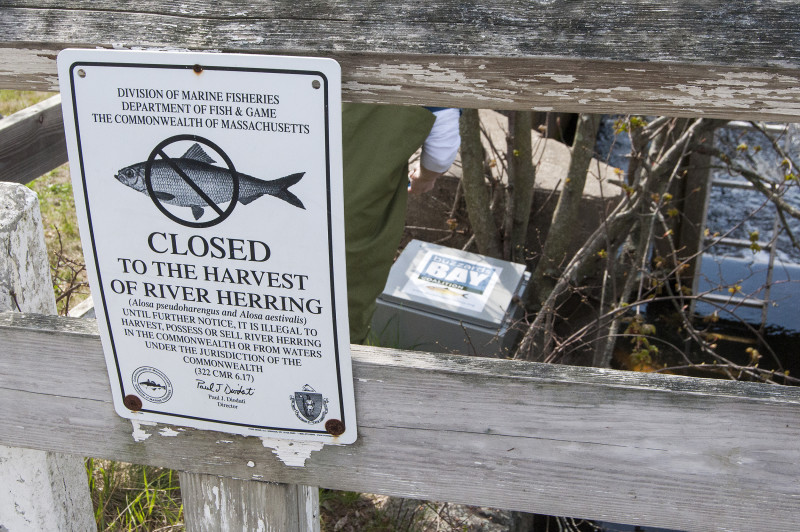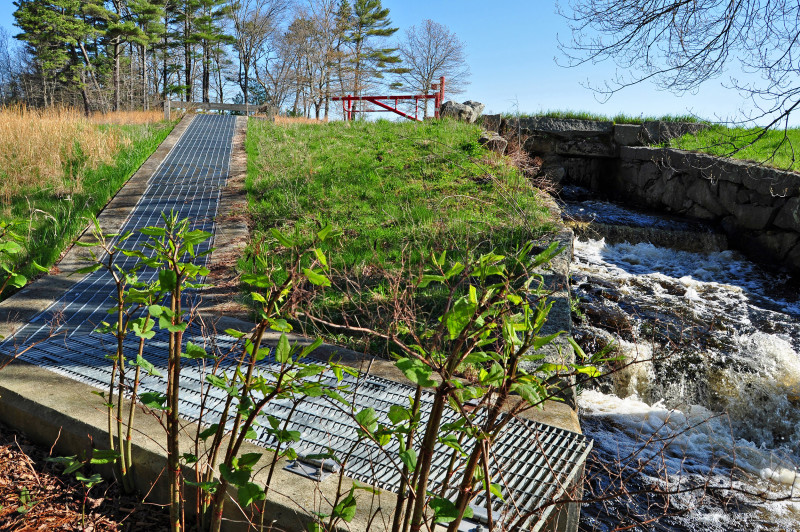What the Acushnet River can teach us about restoring river herring
On a cool, sunny morning in early May, Buzzards Bay Coalition Director of Monitoring Programs Tony Williams pulled up to a section of the Acushnet River flowing through a farm in rural Acushnet, just below the New Bedford Reservoir at Lake Street.
This stretch of the Acushnet River is a gentle freshwater stream winding through the woods – much different than the way it looks farther south, as it widens and tumbles toward urban New Bedford Harbor.
Williams visits this spot every morning in spring, when the annual spawning run of a fish called river herring is in full steam. Along the edge of the river sits a gray metal box marked with the Buzzards Bay Coalition logo and a picture of a fish. It’s a counter, set up next to the fish ladder that was built here in 2002 to help river herring swim around a nearby dam.
Williams grabbed a clipboard and wrote down the number that appeared on the counter: 139. That’s the amount of river herring that had passed up the fish ladder in the past 24 hours.
The day before, Williams had counted 377 fish – nearly the same number of river herring that were recorded on the Acushnet River during the entire year in 2007.
What are river herring?
River herring are somewhat small, silvery fish that grow to about 6-12 inches long. They’re actually two separate fish species – alewives and blueback herring – that are so similar that they’re collectively referred to as “river herring.”
Although they’re small, river herring are considered a “foundation” fish in the Buzzards Bay ecosystem. Many of the Bay’s large sportfish and water birds – including bluefish, striped bass, and ospreys – rely on river herring as food. And river herring feed on plankton in the water, making them an important link in the Bay food web.
Each spring, millions of river herring migrate from the Atlantic Ocean to coastal rivers and streams, like those that flow into Buzzards Bay. The fish that return to the Acushnet River were born here, and they’re back again to spawn and create a new generation of river herring.
That’s what they try to do, at least. But a few things have gotten in their way.
Why are river herring in trouble?

Signs alert visitors to local river herring runs that the fishery is closed.
River herring populations have been in decline for many years. There are a number of factors that led to their downturn, including pollution and overfishing. But dams are one of the biggest problems facing river herring and other migratory fish such as shad and eels. Some species, such as Atlantic salmon, are almost entirely gone from rivers in the Northeast.
Dams, road culverts, and other blockages that cut across rivers stop these fish in their tracks, preventing them from swimming upstream. If river herring can’t reach their spawning areas, they have a much lower chance of successfully reproducing.
A decade ago, things got even worse for river herring. Up and down the East Coast, rivers were recording historic low catches. The stock was collapsing, fast.
There’s another piece of the river herring puzzle – this one located far away from Buzzards Bay, out at sea. Commercial fishing vessels trawling for mackerel, Atlantic herring, and other fish accidentally catch river herring in their nets. This is called bycatch, and it’s a big problem for river herring populations.
No matter the cause, these losses are bad news for the Buzzards Bay ecosystem. Without enough herring swimming up the Bay’s rivers each spring, sportfish and birds have less food to eat.
How has restoring the Acushnet River helped river herring?
In 2006, Massachusetts became one of several East Coast states to ban the catch, sale, and possession of river herring in the state. And fisheries managers are setting limits on the amount of river herring allowed as bycatch in commercial fisheries.
These state and regional policies enacted to protect river herring seem to be helping the fish come back. But on a local scale, projects to restore fish passage are making an enormous difference for migrating river herring.
Back at the fish counter on the Acushnet River, the positive effects of river restoration are clear. In 2014, more than 10,000 herring swam up the Acushnet River – a 68 percent increase from the previous year, and thousands more than the 381 fish that were counted here in 2007.
Along one side of the river runs a long concrete passageway with a metal covering. This is the fish ladder: a type of fishway that allows herring and other migrating fish to bypass the dam that sits on this stretch of the Acushnet River. Think of the fish ladder as a detour lane that lets herring maneuver around blockages that would otherwise keep them stuck behind the dam.
Further down the river, an innovative fishway at the Acushnet Sawmill replaced a dam that was lowered in 2007. This fishway, installed by the NOAA Restoration Center, is a more natural design than the fish ladder. Using carefully placed boulders, engineers created several “pools” that mimic the river’s natural flow. Like a person would climb a flight of stairs, fish jump from pool to pool, stopping to rest in each pool on their journey upriver.
At a third Acushnet River dam near Hamlin Street, about halfway between The Sawmill and the fish ladder, another nature-like fishway was installed in 2008 to allow river herring to complete their journey. For the first time in years, migratory fish can now swim freely from the Atlantic Ocean all the way to the New Bedford Reservoir.
Together, these three Acushnet River projects to improve fish passage recently won the 2014 Distinguished Project Award from two national engineering groups focused on fisheries and water resources. But the real reward is seeing fish return to the river in growing numbers each spring.
Where else are river herring increasing?

River herring enter the Acushnet River fish ladder through the opening on the left. This allows the fish to bypass the dam so they can reach their spawning areas.
The Acushnet River isn’t the only local stream seeing big river herring increases in recent years. Although river herring aren’t increasing everywhere, the overall trend seems to be heading in the right direction.
The Mattapoisett River reported a 156 percent increase in river herring this year. And on the Agawam River in Wareham, the river herring count is slowly ticking upward from less than 20,000 in 2011 to nearly 49,000 in 2014. The Bournedale herring run on Cape Cod Canal was up this year, too.
Still, these numbers represent only a fraction of historic river herring populations that once made the journey up Buzzards Bay into local rivers and streams. Both here and across the region, there’s a lot of work to be done to protect this important species for years to come.
What can people do to help river herring?
The most important thing people can do to help river herring is simple – leave them alone! Because it’s against the law to possess river herring in Massachusetts waters, you should never try to catch or disturb them.
You can also consider supporting organizations like the Coalition that work to improve conditions for river herring and other important wildlife. Through our Baywatchers program, the Coalition monitors herring in several local rivers each spring. We’re also working to restore the places where river herring live, including the Acushnet Sawmill and Horseshoe Mill on the Weweantic River in Wareham.
Finally, get outside and see some river herring for yourself! In spring, local herring runs are full of these silvery fish, piled up in huge schools as they wait their turn to climb up fishways. One reliably good spot to see river herring is the herring run on the Agawam River in Wareham.